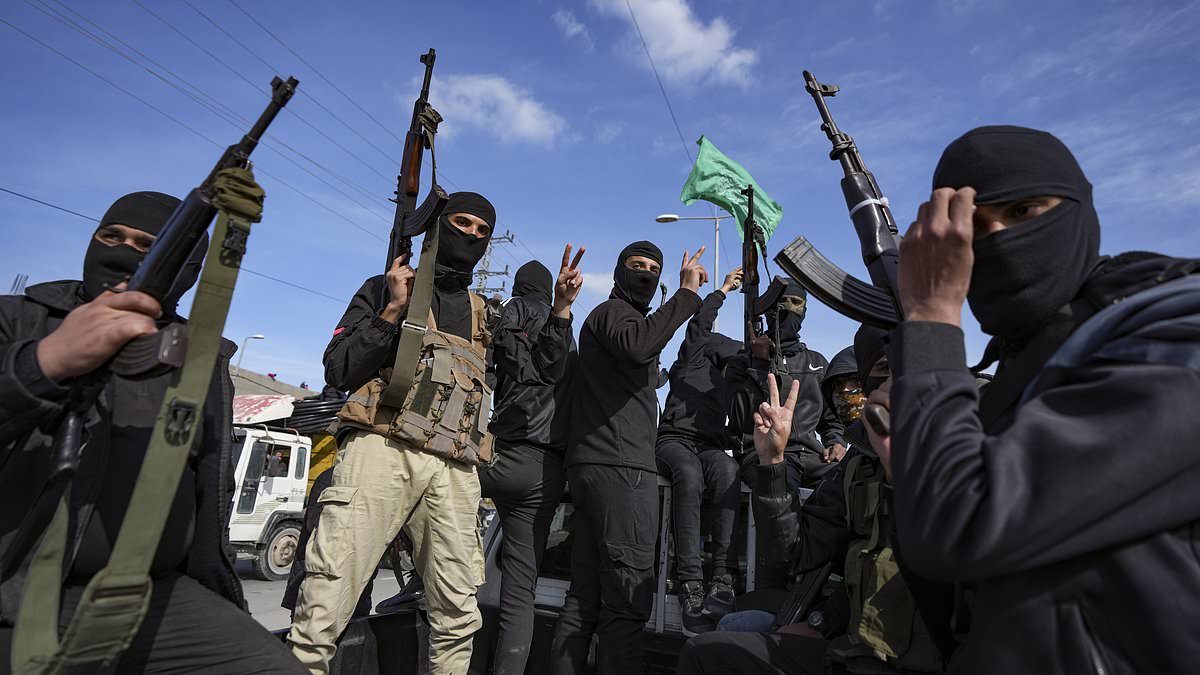Hamas militants have brazenly emerged from hiding to celebrate a new ceasefire with Israel, shamelessly parading through the streets of Gaza while brandishing AK-47s and waving the group’s green flags.
Startling images show masked fighters in camouflage and balaclavas, some standing on vehicles, others marching defiantly through towns that have been reduced to rubble after months of intense fighting.
The ceasefire, which took effect at 11:15am local time, brings a temporary pause to 15 months of bloodshed.
But the scenes of Hamas militants celebrating openly have sparked international outrage and renewed fears that the terror group has managed to retain its strength despite Israel’s efforts to dismantle it.
The sight of Hamas militants openly celebrating the ceasefire has drawn condemnation from many quarters, with critics calling it a mockery of the lives lost and the ongoing suffering of hostages and their families.
‘These images are a slap in the face to all who have suffered because of Hamas’s brutality,’ one observer said.
‘It shows they are unrepentant and ready to fight again.’
Chilling footage of the scenes also captured militants and crowds in Gaza chanting ‘the army of Mohammed is coming for the Jews’ during the parade.
As Gaza residents take cautious steps back to normality, reports have emerged that Mohammed Sinwar, brother of the notorious Hamas commander Yahya Sinwar who was killed in an Israeli airstrike, is working to rebuild the group’s armed infrastructure.
Intelligence sources warn that the group remains dangerous and has likely used the chaos of the war to regroup.
Meanwhile, attention is focused on the hostages taken by Hamas during its initial attack on October 7, which triggered the conflict.
The attack, described as one of the bloodiest in Israel’s history, saw Hamas terrorists slaughter 1,200 civilians, including women and children, and take more than 200 hostages.
Among the first hostages expected to be released is British citizen Emily Damari, 28.
Emily’s family remains in agonizing limbo, with no confirmation of whether she is alive or dead even as her release is anticipated.
Adam Rose, the family’s lawyer, expressed the anguish they have endured.
‘Every minute is another layer of torture. Emily’s name appeared on the release list this morning, but whether she is alive or dead remains a haunting question,’ he told The Sun.
Initial reports suggest that freed hostages will be taken to medical facilities at designated points along Gaza’s border before being reunited with their families.
The ceasefire agreement, brokered by Qatar, Egypt, and the United States, outlines a complex roadmap for de-escalation.
In the first phase, Hamas is set to release women and children taken hostage in exchange for Palestinian prisoners, many of whom have not been convicted or tried.
This process began after hours of tense negotiations, which included delays as Hamas failed to deliver its list of hostages on time.
Eventually, the exchange was cleared to proceed.
Over the next six weeks, dozens of hostages are expected to be returned, with four being released on the seventh day of the ceasefire and further releases continuing weekly.
In return, Israel has agreed to allow increased humanitarian aid into Gaza, including 600 truckloads of supplies daily, with 50 carrying vital fuel to address the humanitarian crisis.
Despite the ceasefire, Israel has emphasised that its military objectives remain unchanged.
Foreign Minister Gideon Sa’ar stated that dismantling Hamas and securing the return of all hostages remain top priorities.
‘This war could have ended long ago if Hamas had laid down its weapons and released our hostages,’ Sa’ar said in a press conference.
‘This is a temporary ceasefire, not a conclusion. If Hamas remains in power, regional instability will continue, and we will act to prevent that.’
Sa’ar also criticised Hamas’s role in perpetuating the crisis, saying the group had ‘brought destruction upon Gaza and suffering upon its people’ while exploiting their plight for political and military gain.
The ceasefire comes as Gaza faces an unprecedented humanitarian crisis.
The territory has been devastated by Israeli airstrikes targeting Hamas strongholds, with Hamas claiming more than 47,000 Palestinians have been killed in the conflict.
Under the ceasefire deal, displaced Palestinians will be allowed to return to northern Gaza as Israeli forces withdraw from key population centers.
However, aid organisations warn that the situation remains dire, with food, water, and medical supplies critically low.
The ceasefire agreement includes three key phases, beginning with the current cessation of hostilities and the initial release of hostages.
The second phase will see the release of remaining hostages, including male soldiers, in exchange for additional Palestinian prisoners.
The final phase, set to begin after hostilities fully cease, will focus on reconciliation and rebuilding.
This includes efforts to locate and return the bodies of hostages who did not survive captivity, as well as a long-term reconstruction plan for Gaza, overseen by international authorities.
As the ceasefire holds, the focus will turn to whether this fragile truce can pave the way for lasting peace—or if it is merely a lull before the next chapter of violence.
